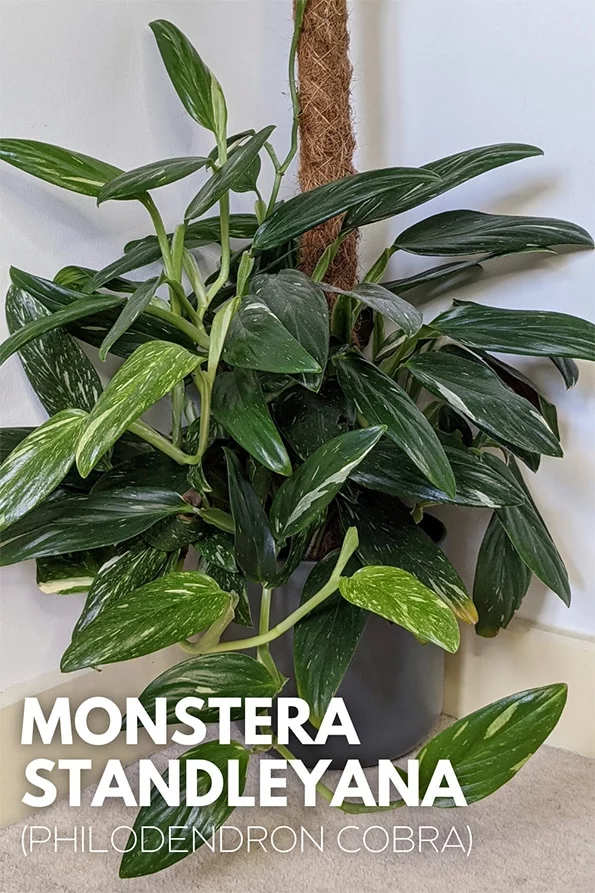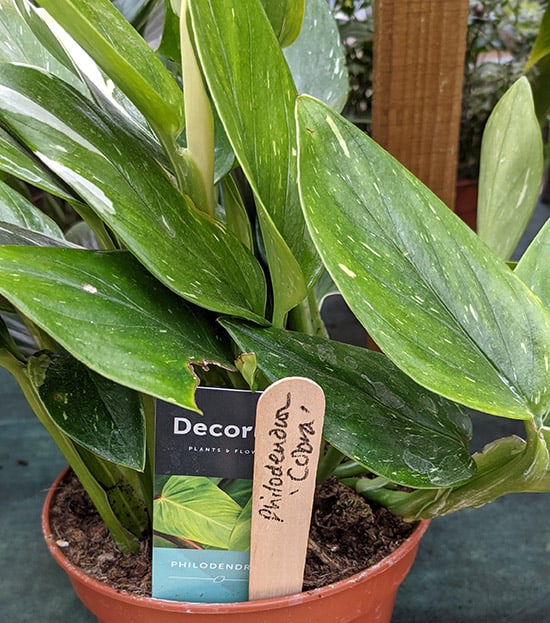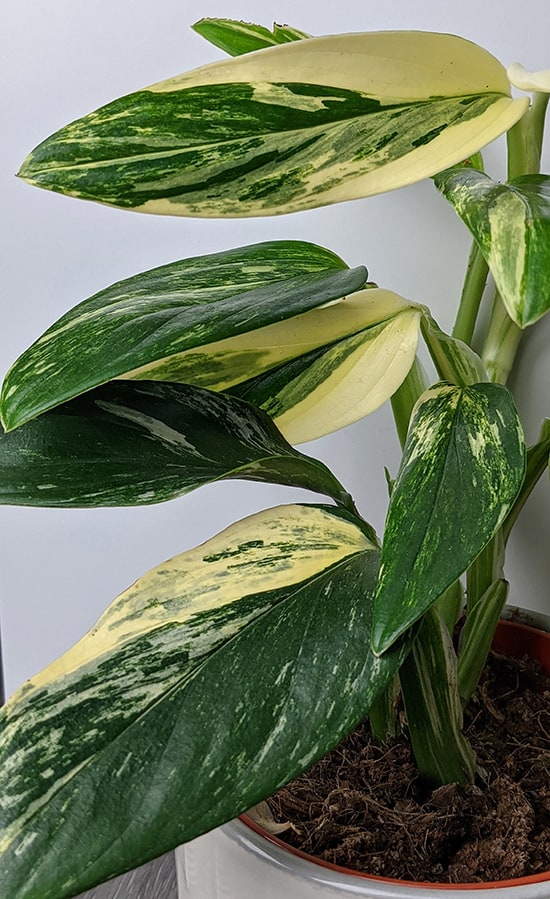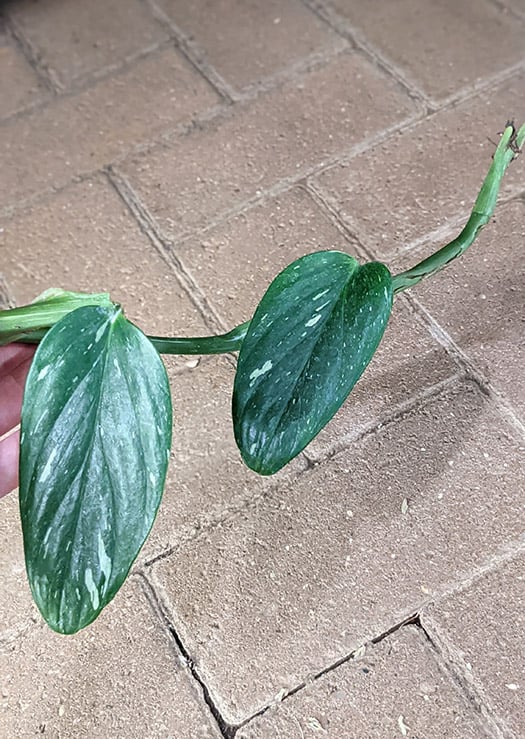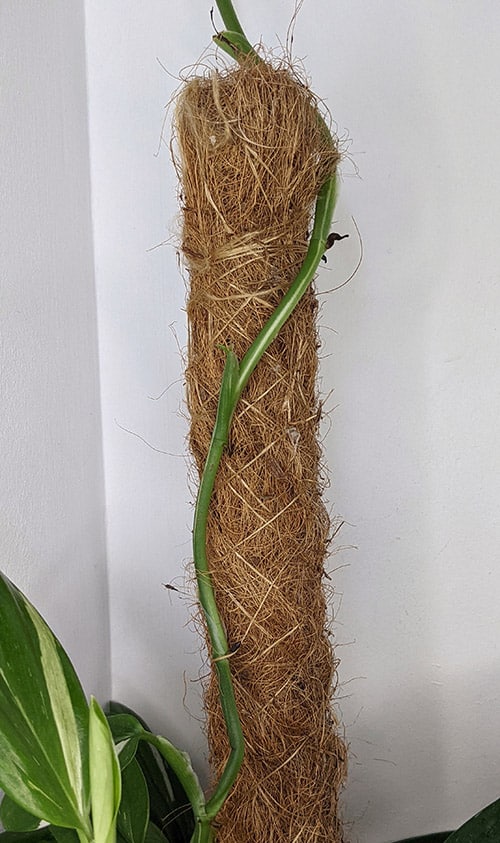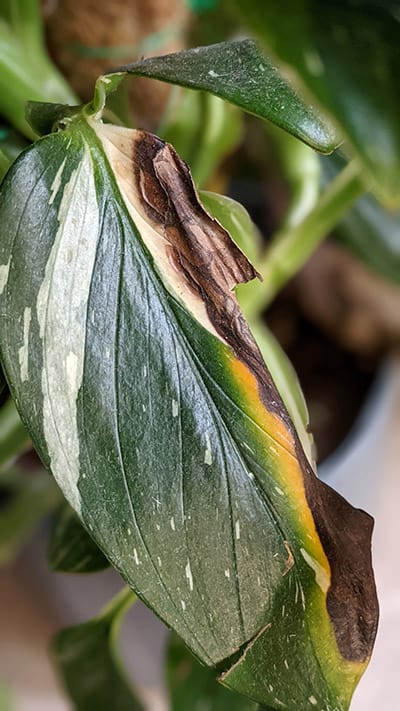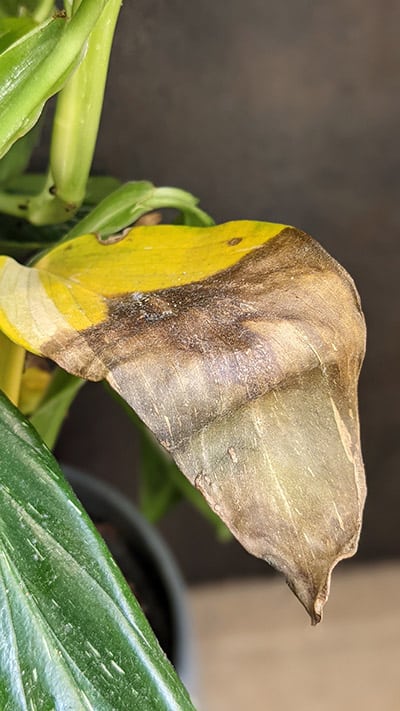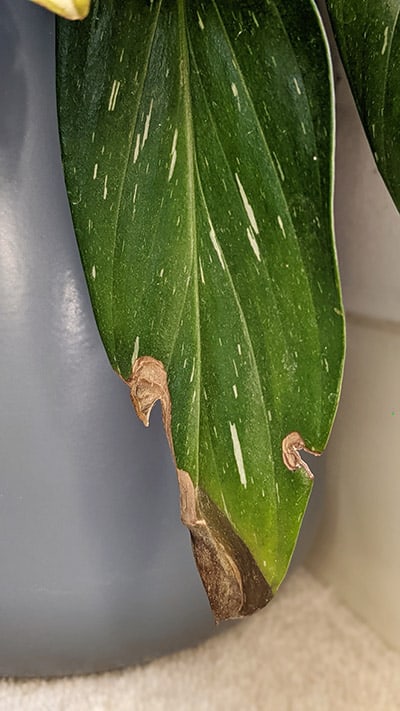Monstera standleyana is a tropical plant that looks nothing like its much more famous cousin, the Monstera deliciosa. But as is true for most Monstera plants, the Standleyana is easy going, and they make for brilliant indoor plants.
The dark green leaves usually have a degree of white or cream variegation that give them a pop. Mix in the robust and hardy Monstera genetics, then combine this with fast growth and you have a fabulous plant that deserves a place in most collections.
With the help of my Monstera Standleyana care guide, you're about to learn everything you need to know about growing this climbing houseplant the right way.
This is a fantastic indoor plant, and my experiences have been almost completely positive. It does have a few quirks that other Monsteras don't, and I'll explain these as we go.
How do you pronounce Monstera Standleyana correctly? Say:
Mon-STAIR-uh stan-DLEE-uh-nuh
It's a top low-maintenance plant that's happy to share our warm living spaces. Even though it's been available as a houseplant for years now and prices are fair, it's still considered a rare plant and you may have trouble finding them in shops.
For such an unusual and fast growing houseplant, it's pretty rare. I've only ever seen it sold by specialist sellers, either in a "rare plant" shop or from Online sellers. Even then, I don't think it's that expensive, at least by today's standards.
Commonly sold as a "Philodendron Cobra", "Philodendron Standleyana" or the "Five Holes Plant". Strange name choices as it's not a Philodendron and doesn't develop any holes (fenestrations) in the leaves.
If you can find a decent sized plant with several vines for under $40 / £30, I think you've got yourself a great deal. $60 / £50 is probably the most I would pay unless it was enormous or had unusual variegation.
Monstera Standleyana vs Philodendron Cobra
You're equally as likely to find this plant being sold as Monstera Standleyana or Philodendron Cobra. Both names are used interchangeably.
This is because it has more visual similarities to a Philodendron than a Monstera.
However, officially the plant is a Monstera and not a Philodendron species. The correct scientific name is, therefore, Monstera Standleyana.
The above pricing relates to the "normal" Monstera Standleyana. This has dark green narrow leaves with the occasional white or cream variegated splash, either as dashes or in larger chunks. In some ways, the markings are similar to the Monstera Albo Variegata or Thai Constellation.
The ordinary one is stunning. However, if you're keen for more, you can get two other versions, although they'll have a higher price tag.
Monstera Standleyana Variegata Albo.
This is similar to the standard
Standleyana, except the variegation is much stronger. Larger sections of the leaf will be completely white and you may have half moon type variegation or even fully pure white leaves.
I've not been able to establish if the variegation on this one is stable or if the plant is likely to revert. If you have any experience with it, I'd love to hear from you.
Monstera Standleyana Aurea.
Similar to the original, except it has lime green or yellow markings that take up more leaf area. Expect it to grow a little slower.
Monstera Standleyana 'Aurea' with its creamy yellow variegation instead of the white markings, which you'll find on the more common variety.
If you're reading this article you probably already own this plant so let's get on with the care instructions to keep your plant healthy. If you have a problem with your Monstera Standleyana, then you can jump to the problem section below.
My written growing guide is next, I also have a video on YouTube for more tips.

Hi, I'm Tom!
If you're like me and enjoy the challenge of growing houseplants and getting them to thrive, then Ourhouseplants can help. This website shares my knowledge and years of growing plants and provides (hopefully) helpful advice on properly caring for your indoor plant friends.
It's surprisingly adaptable when it comes to its light requirements. Too much or too little can mess with its growth habit and create runners (more on that later), but generally, it will tolerate a broad range of lighting.
Avoid low light and direct sunlight spots in your home and you should be good. You'll get the best results with the familiar "bright but indirect light", but it can easily cope with a few hours of morning or evening sunshine.
Top Tip
Monstera Standleyana leaves are dust magnets and the dark semi-glossy leaves make this show up easily, so you might need to give it a regular wipe down to keep things looking fresh.
It will also get by in medium light, for example, 5 or 6 feet away from a west facing window. If the light is too low, you might get "runners".
I've found this Monstera can easily struggle with excessive overwatering and root rot can be an issue. But on the flip-side, it's not fazed (too much) by underwatering.
They're reasonably thirsty plants, especially if several vines are growing in the same planter. Water heavily and then let the top few inches dry out completely before watering again. It can even cope for a few days if the entire potting medium dries out. Just don't do this regularly.
You may notice subtle drooping of the leaves if the soil is too dry. You can also get "crying leaves" if it's been overwatered. These are both early warning signs your watering is a little off. Going forward adapt what you're doing to try avoid these things.
The Monstera Standleyana is highly resilient to extreme humidity levels. It can cope with high humidity levels just as well as lower levels, providing you're giving the right amount of water (see previous section). This means the average home should already have the ideal growing conditions.
Black or brown leaf edges are rare on these plants in most homes. However if your humidity is excessively low, then they can appear.
They have average feeding needs. I give my plant fertilizer, when I remember, usually once a month, sometimes every two. Use a general houseplant feed or one with a higher nitrogen value. You can also add slow release fertilizers when repotting.
If your home temperature is warm, you may see new growth appearing all year around. So if you spot new leaves emerging in Winter, you can give the feed all year round.
If the spot you've chosen for it is on the cool side and growth stops towards the end of Fall / Autumn, stop feeding until the following Spring.
In their native habitat, they come from countries in Central America like Costa Rica and Honduras. This means they grow in tropical climates and respond well to warm or hot temperatures in our homes. Aim for a year round temperature range of between 18°C (64°F) and 25°C (77°F).
If you can keep the temperatures 18°C (64°F) or higher during the cold months of the year with good light levels, it's usual to have new growth continue to appear. No winter rest for these charmers. They make good picks to grow in your living space rather than unused rooms, which are often cooler.
If the temperature does drop, expect growth to stop until the following Spring when it warms up again.
They respond well to warm or hot temperatures.
They do not like cold temperatures. Anything below 10°C (50°F) will not go down well. Not a suitable plant for an unheated sunroom or conservatory, unless you can move them somewhere warmer over the Winter months.
The roots have an average growth rate and it will take a few years to fill a pot. They will benefit from repotting to a slightly larger container every two or three years.
As the roots can be fussy with constantly damp or wet soil from excessive watering, I recommend something that dries out quickly or has good drainage to stop waterlogging. I switched mine to a 100% coconut coir mix a few years ago and it's thriving.
If you're not ready to make the switch, you can use peat free compost, which usually has chunky material like shredded bark added, this helps keep things open and free draining.
I don't like peat for environmental reasons, and you need to be extra careful with this plant and 100% peat compost because of how much water peat can hold. If you insist on using it though, see if you can add some larger materials like grit, perlite or fine orchid bark to try and open it up.
Monstera Standleyana Propagation Help.
I go into detail about how to take a stem cutting, with photos, diagrams and even a quick YouTube video over on the Monstera adansonii article I wrote last year. Check it if you need more help, as the method is identical for both plants.
Generally, Monstera plants are very easy to propagate. The Monstera Standleyana is a little more challenging. The main way to do it, is by stem cuttings. Like so many vining houseplants, you just need to cut the stem a little above the node and put it into soil or water.
The problem is that some leaf nodes don't seem to be active and no roots sprout. The cutting then rots away. I've had this happen in both water and soil.
I suspect it could be a temperature problem, namely it's too cold for them to grow. So for the best chance, try it during the summer or whenever you get regular daytime temperatures above 18°C (64°F).
I'd rate the growth rate as average. It's not a super fast grower and would never win a race against the Mini Monstera, but it's faster than the Monstera deliciosa.
For several months your Standleyana won't do anything. Then suddenly, you'll spot runners and leaves growing rapidly. The new growth is a lighter green and this darkens up after a few months.
Prune your plant for more bushy growth.
Your Standleyana will react positively to some light pruning. It will often respond by growing two or three new vines from a node near where you cut it.
The most common way to grow the plant is upwards, using a moss pole or coconut coir filled totem. It tends to grow tall and slender. If you grow it this way too, you'll quickly understand why it's sometimes called the "Philodendron Cobra".
New leaves tend to point upwards and then as they mature, they tend to fold out and hold themselves at close to 180 degree angles or in horizontal lines sticking out from the main stems. So as the runners climb upwards the plant resembles a cobra rising. Very unusual and striking (pun intended).
My Philodendron Cobra AKA Monstera Standleyana growing up a narrow moss pole.
Small plants with multiple stems in one pot usually look more bushy and compact. This is the most popular way you'll find this plant when you first get it. The "Cobra" look is a mature appearance that comes several years later. Most photos in this article have this bushy juvenile form.
Does the Monstera Standleyana develop fenestrations (holes) in the leaves?
Many Monsteras grow the iconic rips or fenestrations with age, but the Standleyana doesn't. While the leaves can grow larger with maturity, they retain the solid lance shaped leaves.
It rarely flowers indoors, but with age, you may notice the usual flowering spadix and spathe familiar to the Araceae family. It's not anything to write home about, but nice to see.
Many Aroids, including the Standleyana, are mildly toxic because of calcium oxalate crystals within the leaves and stems. However this isn't likely to be a problem even if a pet or person accidentally eats some of the plant.
That said, always take care with your houseplants and keep them out of reach if this could be an issue.
Okay, another annoying trait now. Runners. In the main, these come in two forms. The first is easily dealt with. Let's call them "Runners with leaves." You can see one in the photo below.
This runner has escaped from the central parts of the original plant and is now reaching out of the plant's pot. All it needs is a little guidance from you to get it back to where it should be.
The runner normally sprouts from lower down in the plant and starts reaching and crawling outwards instead of growing up whatever support (if any) you've provided.
Many Monstera plants will grow very robust and strong aerial roots from the nodes on the stems without much encouragement. They use these to cling and hold firm to climbing supports.
However, in comparison, the Standleyana aerial roots are nowhere near as strong. Some nodes don't even form proper aerial roots. This means the runners sort of "escape" and hang there limply.
Propagation Tip.
If you don't want or need the stray runner, you can try air layering or simply remove it and try to propagate a new plant instead.
If there are leaves as shown in the photo above, all you need to do is help it out by attaching it to the climbing support. Use wire, bobby pins or hair clips to hold it in place. If they have good contact with the support, it often encourages aerial roots to form.
If this doesnt work, change your support to a D-Support which should produce better results in time.
You may, however, have the second type of "runner." A stem with no leaves, as you can see below.
Runners without leaves usually mean you're trying to grow it in lower light conditions. Try and provide more and reach the perfect "bright indirect light" level.
As you can see the stem is wrapped nicely around the coir pole, but it has no aerial roots and no leaves are growing on it. What's happening? In this instance, the plant is likely not getting enough light.
The runner doesn't want to waste time or energy, producing leaves when it considers the location too dark. So the vine is trying to get to a new position, hoping there will be more light available. If this happens, leaves should start to grow. But you could be left with inches and inches of empty, bare stem before that happens. Not attractive.
The simplest solution is to just cut the bare runner back to above a node. Move your plant to a brighter area or use a grow light and hopefully this will correct the problem and new growth will form leaves.
Brown Leaf Edges, Tips and yellowing margins
This will be rare and probably caused by several factors happening all at once. Below is a list of things that can cause leaves on your Monstera Standleyana to look like this.
A few things can cause this, including too much direct sunlight, too much or not enough water and low humidity levels.
Curling Leaves.
This is rare but can happen if the light the plant is getting is too high (move it to a lower lit location or provide shading). It could also occur if the potting medium has fully dried and the plant has become dehydrated.
Droopy Limp Leaves.
Freezing temperatures or extreme excess water around the roots can trigger this. Most owners will see this, though if they've forgotten to water their plant. The leaves will commonly hang if they're underwatered.
Crying Leaves.
You may notice water dropping onto the surface below or hanging from the leaf edges. This is called guttation and is a strong sign you're providing way too much water. It's often an early warning sign of a problem, so if it happens often you need to seriously cut down the frequency and amount of water you're providing.
Yellow Leaves.
Yellow leaves can be normal. Older ones towards the bottom of vines will turn yellow after a certain amount of time. They don't last forever, and it's not always something to worry about.
Brown and Yellow markings on the plant's leaves like this are not that common, so you may have a problem to sort out.
However it's an evergreen plant and should drop leaves only rarely. So there are a few occasions where the yellowing might be caused by something else that needs investigating.
Long Stems with no leaves.
This is the annoying "runner" issue. In most cases it's down to low light problems. I talk about them and what you can do, here.
Variegated sections on leaves turning brown.
Houseplants with white variegation tend to suffer from browning on the variegated areas over time. These areas are not productive for the plant and cannot carry out photosynthesis. Eventually, the plant recognizes this and will stop supporting the cells in these areas. This results in these sections dying off and going brown.
Some owners will say providing brighter light or using grow lights can help. I've had moderate success with this myself, but I've never been able to prevent it entirely.
It's fairly common for the white markings on mature leaves to get brown spots like this..
Variegation intermittent or lost.
The variegation on the standard Monstera Standleyana is stable. This means you should never have completely 100% green leaves. However, the amount can vary significantly between each leaf; some will have more than others, which is normal.
You can encourage more to form on future leaves by upping the light levels. If you can't do this, consider setting up some grow lights. You can even use normal LED's for this.
Plant is not climbing the support pole by itself.
Although Monstera Standleyana is a vining houseplant and is easy care, it's not the greatest climber and can be a little clumsy getting up those moss poles unfortunately.
Over time it's usual for it to need a helping hand, and it wants you to tie any loose vines to a growing support. Quickly done and only takes a few minutes every couple of months.
